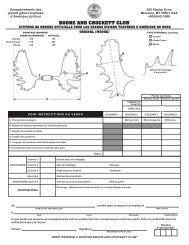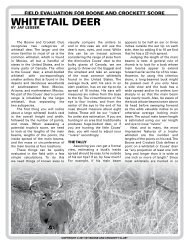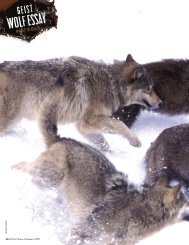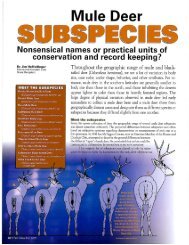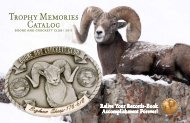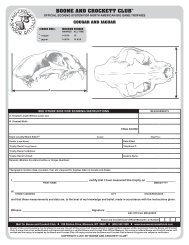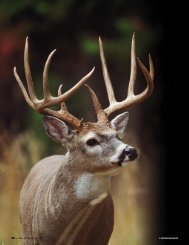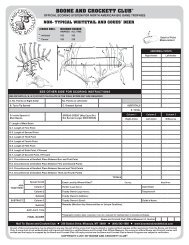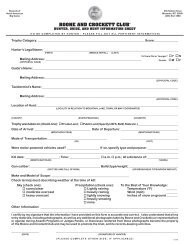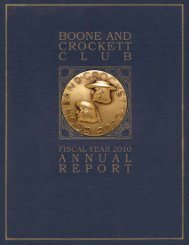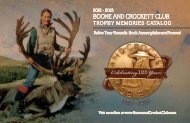ROCKY MOUNTAIN GOAT - Boone and Crockett
ROCKY MOUNTAIN GOAT - Boone and Crockett
ROCKY MOUNTAIN GOAT - Boone and Crockett
You also want an ePaper? Increase the reach of your titles
YUMPU automatically turns print PDFs into web optimized ePapers that Google loves.
Field evaluation For <strong>Boone</strong> <strong>and</strong> CroCkett SCore<br />
roCky Mountain Goat<br />
It would be hard not to classify<br />
any mature Rocky Mountain goat as a<br />
trophy considering all that goes into a<br />
successful hunt for these cliff dwellers.<br />
Nevertheless, as with all antlered <strong>and</strong><br />
horned big game species, there are<br />
certain visual indicators that translate<br />
to <strong>Boone</strong> <strong>and</strong> <strong>Crockett</strong> score that are<br />
valuable tools in judging size of horn<br />
in the field.<br />
Accurately field-judging<br />
mountain goats has a unique set of<br />
challenges. For one, both males <strong>and</strong><br />
females have horns or antler. The<br />
only other North American big game<br />
species to regularly exhibit this<br />
characteristic are pronghorn, sheep<br />
<strong>and</strong> caribou. In these instances<br />
female horn or antler growth is<br />
significantly smaller, <strong>and</strong> therefore<br />
this feature alone makes identifying<br />
sex in the field rather easy. For<br />
mountain goats this is not the case,<br />
in fact many wildlife departments<br />
allow the taking of nannies purely<br />
due to the difficulty of ascertaining<br />
the correct sex quickly in the field.<br />
They encourage hunters to avoid<br />
nannies <strong>and</strong> in many cases require<br />
an orientation course on identifying<br />
billies <strong>and</strong> yet nannies are still<br />
mistakenly taken. The key to making<br />
this determination <strong>and</strong> evaluating a<br />
goat lies in mass of both horns <strong>and</strong><br />
body. Nannies rarely grow the mass<br />
needed to make B&C minimums<br />
(47 Awards, 50 all-time book). The<br />
mature billy will exhibit a definitive<br />
hump on his back or shoulder <strong>and</strong><br />
will overall appear “thicker” than<br />
a nanny. The horns of a billy will<br />
curl over their entire length while a<br />
nannies horns will commonly rise<br />
straight up, only curling back on the<br />
upper 1/3 or 1/4 of the horn.<br />
Another factor to keep in mind<br />
is that normally a trophy goat will<br />
be a loner. This creates a special<br />
challenge for field judging since<br />
outside of the rutting season (late<br />
November), one seldom sees a<br />
mature billy other than alone or as<br />
one of a small group. Since a loner is<br />
not necessarily always a big mature<br />
billy, an assessment of his size, bulk,<br />
apparent horn length <strong>and</strong> mass is<br />
essential to proper identification of a<br />
high scoring trophy though there is<br />
usually not a medium or small billy<br />
close by for comparison.<br />
The length of each horn is factored<br />
into the final score, so lets start there.<br />
When estimating horn length we must<br />
take into consideration two factors.<br />
One is that horn, especially on males,<br />
will grow in a curved, backward<br />
configuration <strong>and</strong> depending on the<br />
time of year hunted, long winter coats<br />
can hide horn growth at the bases<br />
near the skull.<br />
The curvature of the horn can<br />
short change the true length of horns<br />
Copyright © 2011 by boone <strong>and</strong> CroCkett Club ®<br />
in field observations, so it is a good<br />
idea to try <strong>and</strong> visualize the horns as<br />
straight. If the apparent horn length<br />
is visualized as straightened-out,<br />
<strong>and</strong> it reaches the distance from the<br />
nostrils to the bottom of the eye,<br />
you are looking at a horn length of<br />
probably at least eight, but not over<br />
nine inches. If the same comparison<br />
yields an apparent length equivalent<br />
to the distance from the nostrils to<br />
the ear hole, you are unquestionably<br />
looking at a records-class billy,<br />
providing his horn tips are not<br />
broken <strong>and</strong> he appears to have a<br />
thick base on each horn.<br />
Another useful gauge is the<br />
apparent length of the horns<br />
compared to the visible length of the<br />
ear. For trophy quality, one normally<br />
must look for a horn that appears to<br />
be two <strong>and</strong> one-half times the visible<br />
length of the ear.<br />
Judging the base of a billy goat’s<br />
horns is a fine art. Though a general<br />
rule to use is that when viewed<br />
straight on the bases will appear to<br />
nearly touch, on a nanny or lesser<br />
billy white will be definitively visible.<br />
Be cautious though since billy’s<br />
possess two large black gl<strong>and</strong>s<br />
directly behind the horns which can<br />
be mistaken for extraordinary mass.<br />
Nannies do not have this gl<strong>and</strong>. A<br />
look to the records reveals that the<br />
best bases <strong>and</strong> ultimately the best<br />
scoring goats come from the Pacific<br />
Coast range, or the west slope of the<br />
Rockies, or in the Cassiars. Obviously<br />
there are exceptions, but <strong>Boone</strong><br />
<strong>and</strong> <strong>Crockett</strong> records data supports<br />
the exceptional bases being more<br />
common from Coast Range goats.<br />
Reviewing the top 100 records<br />
book goats of All-Time, you will<br />
find the base circumferences<br />
range from 6 to 6-6/8 with all but<br />
ten entries coming from northern<br />
coastal locations. The other locations<br />
showing up in the top 100 include;<br />
Washington, Oregon, Idaho, Utah,<br />
Montana, Colorado, <strong>and</strong> Nevada.<br />
The remaining 90 entries are all from<br />
costal Alaska <strong>and</strong> British Columbia.
MaXiMuM vS. MiniMuM<br />
a CoMpariSon oF two reCordS-Book roCky Mountain Goat<br />
world’S reCord<br />
roCky Mountain Goat<br />
SCore: 56-6/8<br />
trophy analySiS<br />
n Exceptional length – both measure 12 inches<br />
n Exceptional bases – both measure 6-4/8 inches<br />
n Mass carries well –<br />
1st Quarter 4-7/8 inches<br />
2nd Quarter 3-2/8 inches<br />
3rd Quarter 2 inches<br />
n Only 2/8 inch for symmetry deduction<br />
CloSe to MiniMuM entry<br />
roCky Mountain Goat<br />
SCore: 47-4/8<br />
trophy analySiS<br />
n Average length –<br />
averaging 10 inches<br />
n Above average bases – measuring<br />
5-4/8 <strong>and</strong> 5-3/8 inches<br />
n Mass drops significantly at<br />
second Quarter<br />
n Nearly one inch of symmetry<br />
deduction<br />
reSourCeS availaBle FroM the <strong>Boone</strong> <strong>and</strong> CroCkett CluB<br />
<strong>Boone</strong> <strong>and</strong> <strong>Crockett</strong> Club Field Guide to Measuring <strong>and</strong> Judging Big Game, 2nd edition<br />
The definitive manual for anyone<br />
with a desire to learn the <strong>Boone</strong> <strong>and</strong><br />
<strong>Crockett</strong> Club’s world-famous big game<br />
measuring system is now available in<br />
this updated, convenient field guide that<br />
easily fits into backpacks.<br />
Inside you will find detailed instructions<br />
on how to score each of the native<br />
North American big game categories<br />
recognized by the Club, including<br />
numerous illustrations to clearly<br />
demonstrate techniques for proper<br />
measurement. Also included in this field<br />
guide are techniques for evaluating <strong>and</strong><br />
field judging the most popular species<br />
of North American big game.<br />
For More inForMation or to order viSit<br />
www.<strong>Boone</strong><strong>and</strong>CroCkettCluB.CoM or Call 406-542-1888<br />
Copyright © 2011 by boone <strong>and</strong> CroCkett Club ®<br />
Other important sections of the field guide include:<br />
n A chapter on general measuring techniques for<br />
native North American big game<br />
n Scoring instructions <strong>and</strong> scorecharts for all<br />
38 categories of North American big game<br />
recognized by the Club<br />
n Boundary descriptions for species such as elk,<br />
blacktail deer, grizzly <strong>and</strong> Alaska brown bear,<br />
whitetail, <strong>and</strong> caribou<br />
n Table of the quarter locations for easy reference<br />
when measuring all big game categories<br />
with horns<br />
n A chapter on underst<strong>and</strong>ing the dynamics of<br />
hunting <strong>and</strong> spotting optics.
A & B dO NOT<br />
CALCuLATE IN THE<br />
FINAL SCORE BuT<br />
ARE REquIREd<br />
C. Length of Horn<br />
d-1. Circumference of Base<br />
BOONE AND CROCKETT CLUB ®<br />
OFFICIAL SCORING SYSTEM FOR NORTH AMERICAN BIG GAME TROPHIES<br />
MiNiMUM SCORES<br />
AwARdS ALL-TIME<br />
47 50<br />
C<br />
ROCKy MOUNTAiN <strong>GOAT</strong><br />
D1<br />
D2<br />
D3<br />
I, ________________________________________________, certify that I have measured this trophy on ___________________<br />
PRINT NAME MM/dd/YYYY<br />
at ________________________________________________________________________________________________________<br />
STREET AddRESS CITY STATE/PROvINCE<br />
<strong>and</strong> that these measurements <strong>and</strong> data are, to the best of my knowledge <strong>and</strong> belief, made in accordance with the instructions given.<br />
witness: _______________________________________________ Signature: ________________________________________________<br />
B&C OFFICIAL MEASuRER<br />
No part of this scoring system may be altered in any way. No part of this score chart may be altered or copied without express written permission from the <strong>Boone</strong> <strong>and</strong> <strong>Crockett</strong><br />
Club. A score chart is not authenticated until signed <strong>and</strong> dated by a certified <strong>Boone</strong> <strong>and</strong> <strong>Crockett</strong> Club Official Measurer. No scores are official <strong>Boone</strong> <strong>and</strong> <strong>Crockett</strong> scores until<br />
verified <strong>and</strong> the trophy is accepted by the <strong>Boone</strong> <strong>and</strong> <strong>Crockett</strong> Club. All trophy entries into the <strong>Boone</strong> <strong>and</strong> <strong>Crockett</strong> Club’s Awards Programs are subject to verification.<br />
COPYRIGHT © 2011 BY BOONE ANd CROCkETT CLuB ®<br />
D4<br />
SEE OTHER SIdE FOR SCORING INSTRuCTIONS Column 1 Column 2 t Column 3<br />
A. Greatest Spread<br />
B. Tip to Tip Spread<br />
d-2. Circumference at First quarter Location of First quarter Circumference: _________________<br />
d-3. Circumference at Second quarter Location of Second quarter Circumference: _________________<br />
d-4. Circumference at Third quarter Location of Third quarter Circumference: _________________<br />
Add<br />
TOGETHER:<br />
TOTALS<br />
B<br />
A<br />
C<br />
Right Horn Left Horn difference<br />
Column 1 Exact Locality where killed:* County: State/Prov:<br />
Column 2 Hunter (Legal Name): date killed:<br />
Subtotal Trophy Owner (Legal Name): Telephone #:<br />
SuBTRACT: Column 3 Trophy Owner’s Address:<br />
FINAL SCORE<br />
Trophy Owner’s Email: Guide’s Name:<br />
Remarks (Mention Any Abnormalities or unique qualities):<br />
* Geographic location (lake, mountain, river, etc.) required for trophies taken in Canada <strong>and</strong> Alaska.<br />
<strong>Boone</strong> <strong>and</strong> <strong>Crockett</strong> Club © Official Measurer I.D. Number<br />
Mail To: <strong>Boone</strong> <strong>and</strong> <strong>Crockett</strong> Club n 250 Station drive, Missoula, MT 59801 n (406) 542-1888 n www.boone<strong>and</strong>crockettclub.com
pROTECT yOUR hUNTiNG hERiTAGE<br />
Join the <strong>Boone</strong> <strong>and</strong> <strong>Crockett</strong> Club <strong>and</strong> help promote fair Chase hunting!<br />
The single-most critical element facing the future of hunting <strong>and</strong> our wildlife<br />
is the continued public acceptance of recreational hunting.<br />
when hunting is viewed as a fair <strong>and</strong> ethical endeavor in support of<br />
science-based game management programs the voting majority<br />
(non-hunters) accept hunting. Join your fellow hunterconservationists<br />
who believe that ethical sportsmanlike<br />
behavior is the only way to ensure a positive public image<br />
of hunters <strong>and</strong> hunting. Become a part of 120-year-old<br />
commitment to preserving our hunting heritage.<br />
MiSSiON STATEMENT<br />
It is the policy of the <strong>Boone</strong> <strong>and</strong> <strong>Crockett</strong> Club to<br />
promote the guardianship <strong>and</strong> provident management<br />
of big game <strong>and</strong> associated wildlife in North America<br />
<strong>and</strong> maintain the highest st<strong>and</strong>ards of fair chase <strong>and</strong><br />
sportsmanship in all aspects of big game hunting,<br />
in order that this resource of all the people may<br />
survive <strong>and</strong> prosper in its natural habitats. Consistent<br />
with this objective, the Club supports the use <strong>and</strong><br />
enjoyment of our wildlife heritage to the fullest extent<br />
by this <strong>and</strong> future generations.<br />
By joining today you will receive:<br />
n Four issues of Fair Chase, the official<br />
publication of the <strong>Boone</strong> <strong>and</strong> <strong>Crockett</strong> Club.<br />
n A 20% discount on Club books.<br />
n Access to exclusive areas of the Club’s<br />
web site.<br />
n wallet I.d. card <strong>and</strong> a Hunt Fair Chase<br />
window decal.<br />
TO SiGN Up fOR A ONE yEAR ASSOCiATE MEMBERShip fOR $35 CALL TOLL-fREE<br />
(888) 840-4868 OR JOiN ONLiNE AT<br />
www.<strong>Boone</strong><strong>and</strong><strong>Crockett</strong>Club.com<br />
BOONE AND CROCKETT CLUB ®<br />
iNSTRUCTiONS fOR MEASURiNG ROCKy MOUNTAiN <strong>GOAT</strong><br />
All measurements must be made with a 1/4‑inch wide flexible steel tape to the nearest one‑eighth of an inch. Wherever it is necessary to change<br />
direction of measurement, mark a control point <strong>and</strong> swing tape at this point. Enter fractional figures in eighths, without reduction. Official<br />
measurements cannot be taken until the horns have air dried at a habitable room temperature for at least 60 days after the animal was killed. The<br />
60‑day drying period for a trophy that has been frozen or boiled begins the day it is removed from the freezer or boiling pot, or submersion in any<br />
liquid.<br />
A. Greatest Spread is measured between perpendiculars at a right angle to the center line of the skull. Greatest spread does not add<br />
into the final score.<br />
B. Tip to Tip spread is measured between tips of the horns. Tip to tip spread does not add into the final score.<br />
C. Length of Horn is measured from the lowest point in front over outer curve to a point in line with tip.<br />
D‑1. Circumference of Base is measured at a right angle to axis of horn. Do not follow irregular edge of horn; the line of measurement must<br />
be entirely on horn material.<br />
D‑2‑3‑4. Divide measurement C of longer horn by four. Starting at base, mark both horns at these quarters (even though the other horn is<br />
shorter) <strong>and</strong> measure circumferences at these marks, with measurements taken at right angles to horn axis.



